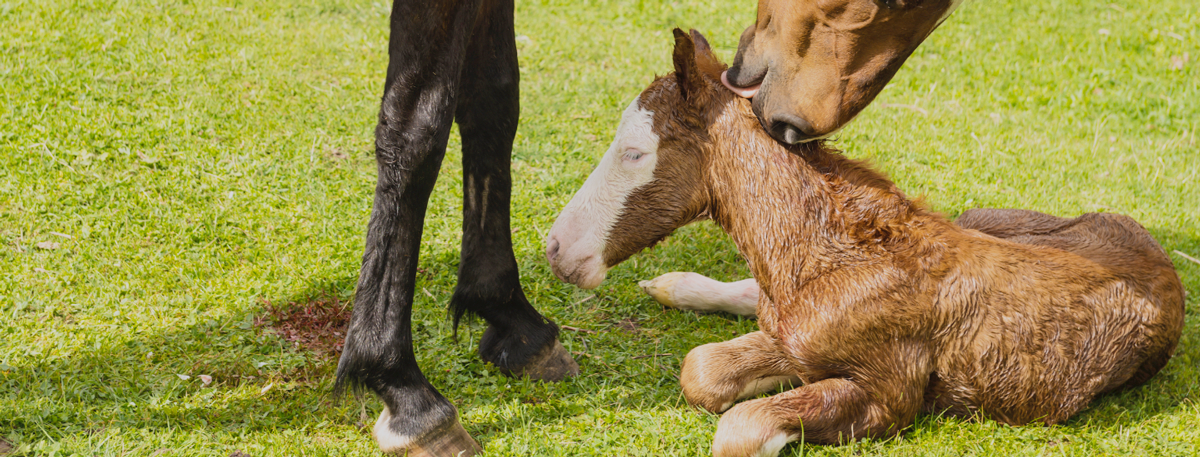
Foal Care
Delivery and Newborn Foal Care
Delivery and Newborn Foal Care
The average gestation length for most mares is 335 to 340 days (range 320 to 362 days). Normal signs of impending delivery include gradual udder development 2 to 6 weeks prior to delivery. The mare’s teats wax within hours to a few days prior to foaling. Her mammary secretions change from clear and watery to opaque and sticky as delivery approaches.
Contact your veterinarian if your mare demonstrates vaginal discharge and/or premature udder development or begins leaking milk well before her due date. These can be warning signs of placental disease and a compromised pregnancy.
THE STAGES OF LABOR:
A Foal is Born
Stage 1 labor
lasts about one to five hours
- Onset of mild uterine contractions
- Restless behavior
- Mild colic signs
- Tail switching
- Sweating
- Circling
- Lying down and rising
- Fetal repositioning to prepare for delivery
- Cervical dilation
- Most deliveries occur late night to early morning
- If the mare is disturbed during this time, stage 1 labor may cease
Stage 2 labor
lasts about 10 to 30 minutes
- Begins with rupture of the chorioallantoic membrane at the cervix and is accompanied by the passage of a large volume of allantoic fluid.
- Followed by appearance of the white translucent amniotic sac at the vulva covering the foal’s forelimbs and head. The foal should be presented with both forelimbs extended (one slightly ahead of the other) followed by the outstretched head.
- Majority of mares will foal lying down.
- If your mare experiences what appears to be prolonged labor or if the foal appears in an abnormal position, contact your veterinarian immediately.
Stage 3 labor
should be complete within 3 hours after delivery
- Passage of the placenta
- Weigh the placenta and save it for your veterinarian to examine to look for signs of disease and to be certain that the entire placenta has been passed. A normal placenta should weigh approximately 10 percent of your foal’s birth weight. A heavy placenta may be indicative of infection or congestion.
- It’s important that your mare does not retain her placenta, as that could lead to a uterine infection that may affect future fertility, cause laminitis or result in a potentially fatal uterine infection. Contact your veterinarian prior to delivery to discuss appropriate expectations when placenta should pass after delivery.
What to Watch for in Your Newborn Foal:
NORMAL OBSERVATIONS
Parameter
Temperature:
99°F – 102°F
Heart rate:
Breathing rate at rest:
Meconium:
Nursing frequency:
Placental weight:
Birth weight and height:
Newborn foal care involves close observation
The first few hours of your foal’s life are critical. A healthy newborn foal should be able to stand within one hour of delivery and should be nursing within two hours. If your foal is too weak to stand and nurse, contact your veterinarian immediately. Common causes of newborn foal illness include overwhelming bacterial infection (septicemia), prematurity and/or neonatal maladjustment syndrome (neurological dysfunction associated with lack of oxygen before or during delivery). Early veterinary intervention can be lifesaving.
Dip your foal’s umbilical stump with dilute chlorhexidine or iodine twice daily for 2-3 days or until the stump is dry. Every foal should pass its first manure, or meconium, within 12-24 hours of delivery. Meconium is pasty or pelleted in consistency and dark brown or black in color. Following meconium passage, the foal’s feces should be soft and light tan in color. A prophylactic enema administered shortly after birth helps reduce the risk of meconium impaction.
Your foal should ingest at least 1-2 pints of good quality colostrum within the first 24 hours life to ensure absorption of adequate antibodies. Peak absorption occurs during the first 6-12 hours following birth. The primary antibody in colostrum is IgG. Healthy foals that have nursed and absorbed adequate colostrum have an IgG concentration in their bloodstream of at least 800 mg/dl. Your veterinarian can draw a blood sample from your foal within 18-24 hours of delivery and can quickly and accurately measure the IgG concentration. Normal foals will have an IgG level in excess of 800 mg/dL, any foal measuring less than 400 mg/dL should receive supplemental colostrum and/or a plasma transfusion to provide vital antibodies that help reduce the risk of serious bacterial and viral infections during the first few months of life those between 400 and 800 should be treated or retested to make sure they are protected. A complete blood count can also be performed on each newborn foal to detect early signs of infection or anemia.
You should observe your newborn foal frequently during the first few weeks of life to detect early signs of disease. Often the first sign of a sick foal is lethargy and decreased nursing vigor accompanied by an overly distended udder on the mare. Young foals are at risk for a variety of respiratory diseases and diarrhea. Monitor your young foal’s breathing rate and effort, body temperature, nursing behavior and manure consistency.
